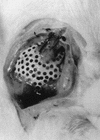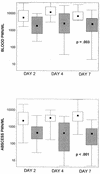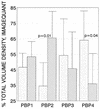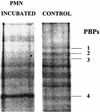Effects of neutrophils on cefazolin activity and penicillin-binding proteins in Staphylococcus aureus abscesses
- PMID: 12183241
- PMCID: PMC127421
- DOI: 10.1128/AAC.46.9.2878-2884.2002
Effects of neutrophils on cefazolin activity and penicillin-binding proteins in Staphylococcus aureus abscesses
Abstract
Bacteria survive within abscesses despite antimicrobial therapy, usually necessitating drainage. Our previous work showed that bacterial killing is diminished within the neutrophils of animals with abscesses. To further assess the role of neutrophils in Staphylococcus aureus survival and the poor activities of beta-lactams in abscesses, tissue cage abscess-bearing rats were given polymorphonuclear leukocyte (PMN)-depleting antibody prior to and several times following inoculation of the tissue cages with S. aureus. Cefazolin (300 mg/kg of body weight/day) was administered to all animals in appropriately divided doses. After 7 days of antimicrobial therapy, the 17 animals that received anti-PMN serum had significantly fewer abscess neutrophils than the 18 controls and fewer abscess bacteria (5.55 versus 3.79 log(10) CFU/ml [P = 0.04]) than the 18 controls. The data were consistent with the premise that cefazolin is more effective in abscesses depleted of neutrophils. To investigate further, S. aureus was incubated with rat peritoneal neutrophils; and bacterial cell membrane proteins were isolated, labeled with biotinylated ampicillin, separated by electrophoresis, blotted onto nitrocellulose, and stained for biotin reactivity. PBP 2 expression was consistently and significantly decreased after a brief, nonkilling PMN exposure. These experiments showed that PMN depletion enhanced the activity of cefazolin in the abscess milieu. Furthermore, altered bacterial cell wall cefazolin targets may be the mechanism by which the PMN diminishes antimicrobial activity, suggesting the importance of the staphylococcus-PMN interaction in the outcome of established infections.
Figures






Similar articles
-
Interaction of cephalosporins with penicillin-binding proteins of methicillin-resistant Staphylococcus aureus.J Antimicrob Chemother. 1989 Apr;23 Suppl D:13-9. doi: 10.1093/jac/23.suppl_d.13. J Antimicrob Chemother. 1989. PMID: 2722720
-
The effect of zinc on microbial growth and bacterial killing by cefazolin in a Staphylococcus aureus abscess milieu.J Infect Dis. 1993 Oct;168(4):893-6. doi: 10.1093/infdis/168.4.893. J Infect Dis. 1993. PMID: 8376834
-
Synergy of sulbactam and ampicillin against methicillin-resistant staphylococci.Drugs Exp Clin Res. 1986;12(12):939-42. Drugs Exp Clin Res. 1986. PMID: 3032552
-
Penicillin-binding proteins and role of amdinocillin in causing bacterial cell death.Am J Med. 1983 Aug 29;75(2A):9-20. doi: 10.1016/0002-9343(83)90089-x. Am J Med. 1983. PMID: 6311012 Review.
-
Amoxycillin-clavulanate versus methicillin or isoxazolyl penicillins for treatment of Staphylococcus aureus infections.J Antimicrob Chemother. 1995 Mar;35(3):435-41. doi: 10.1093/jac/35.3.435. J Antimicrob Chemother. 1995. PMID: 7782261 Review. No abstract available.
Cited by
-
Transient interference with staphylococcal quorum sensing blocks abscess formation.Proc Natl Acad Sci U S A. 2005 Feb 1;102(5):1691-6. doi: 10.1073/pnas.0407661102. Epub 2005 Jan 21. Proc Natl Acad Sci U S A. 2005. PMID: 15665088 Free PMC article.
-
Clearance of Persistent Staphylococcus aureus Bacteremia in a Preterm Neonate With the Use of Combination Cefazolin and Ertapenem.J Pediatr Pharmacol Ther. 2020;25(6):547-551. doi: 10.5863/1551-6776-25.6.547. J Pediatr Pharmacol Ther. 2020. PMID: 32839659 Free PMC article.
-
A microtiter plate-based beta-lactam binding assay for inhibitors of high-molecular-mass penicillin-binding proteins.Anal Biochem. 2010 Jan 1;396(1):164-6. doi: 10.1016/j.ab.2009.09.004. Epub 2009 Sep 11. Anal Biochem. 2010. PMID: 19748471 Free PMC article.
-
Expression of Bacteroides fragilis hemolysins in vivo and role of HlyBA in an intra-abdominal infection model.Microbiologyopen. 2013 Apr;2(2):326-37. doi: 10.1002/mbo3.76. Epub 2013 Feb 26. Microbiologyopen. 2013. PMID: 23441096 Free PMC article.
-
Cefazolin and Ertapenem, a Synergistic Combination Used To Clear Persistent Staphylococcus aureus Bacteremia.Antimicrob Agents Chemother. 2016 Oct 21;60(11):6609-6618. doi: 10.1128/AAC.01192-16. Print 2016 Nov. Antimicrob Agents Chemother. 2016. PMID: 27572414 Free PMC article.
References
-
- Anhalt, J. 1981. Antimicrobial assays, p. 692-699. In J. A. Washington (ed.), Laboratory procedures in clinical microbiology. Springer-Verlag, New York, N.Y.
-
- Bamberger, D. M. 1996. Outcome of medical treatment of bacterial abscesses without therapeutic drainage: review of cases reported in the literature. Clin. Infect. Dis. 23:592-603. - PubMed
-
- Bamberger, D. M., and B. L. Herndon. 1990. Bactericidal capacity of neutrophils in rabbits with experimental acute and chronic abscesses. J. Infect. Dis. 162:186-192. - PubMed
-
- Bamberger, D. M., B. L. Herndon, M. Dew, R.P. Chern, H. Mitchell, L. E. Summers, R. F. Marcus, S. C. Kim, and P. R. Suvarna. 1997. Efficacies of ofloxacin, rifampin, and clindamycin in treatment of Staphylococcus aureus abdominal abscesses and correlation with results of an in vitro assay of intracellular bacterial killing. Antimicrob. Agents Chemother. 41:1178-1181. - PMC - PubMed
Publication types
MeSH terms
Substances
LinkOut - more resources
Full Text Sources
Medical
Research Materials
Miscellaneous

